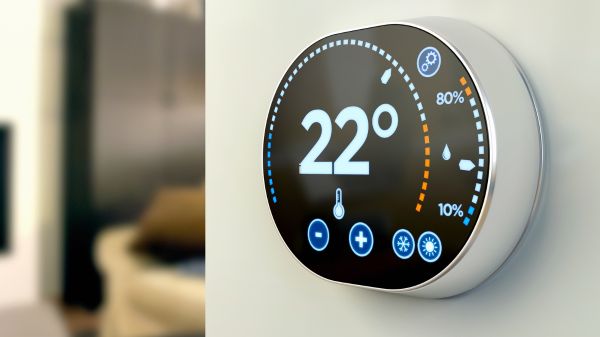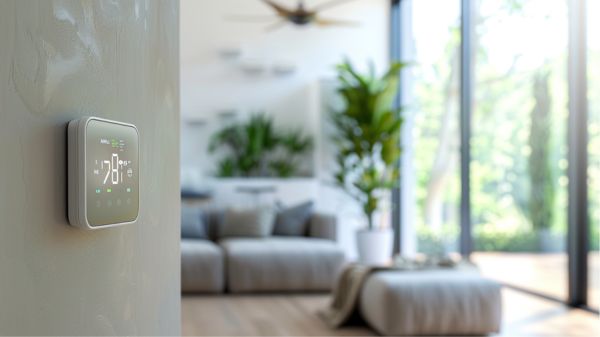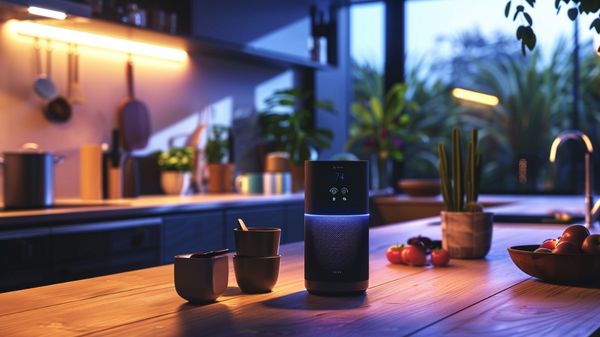As we step into 2024, the quest for reducing household energy expenditures remains a critical concern for many. Innovations in technology have paved the way for a range of modern gadgets to reduce electric bill. These devices not only promise significant reductions in electric bills but also support sustainable living practices.
From smart thermostats that fine-tune your home’s heating and cooling, to solar panel kits that harness renewable energy, these tools are designed to optimize energy usage efficiently. However, choosing the right gadgets requires understanding their functionality and potential savings. To assist in making informed decisions, let us explore how these top 10 gadgets can transform your energy consumption profile.
Key Takeaways
- Smart thermostats automate heating and cooling, potentially saving 10-15% on related energy costs.
- LED lighting systems use up to 75% less energy and have a lifespan of 25,000 hours.
- Solar panel kits can offset up to 90% of electricity costs with a payback period of 5-10 years.
- Energy monitoring devices provide real-time consumption data and can save over 10% on monthly bills.
Smart Thermostats
Smart thermostats represent a considerable advancement in residential energy management, offering potential savings of 10-15% on heating and cooling costs through automated and adaptive temperature adjustments.
These devices enhance smart power utilization by learning and adapting to household routines, greatly optimizing energy efficiency without requiring constant manual adjustments. By integrating with home automation systems, smart thermostats allow homeowners to control their heating and cooling remotely.
This kind of programmability guarantees that energy is not expended unnecessarily when the home is unoccupied, aligning convenience with cost-effectiveness.
Further, the incorporation of programmable thermostats within the broader framework of smart home technology marks a pivotal move towards more sustainable living practices. The ability to set specific temperatures for different times of the day means that users can maximize their comfort while minimizing their energy use.
The additional feature of energy usage reports provides valuable insights into consumption patterns, offering users clear paths to further reduce their energy costs. This data-driven approach not only supports individual savings but also contributes to wider environmental benefits by reducing the overall demand for energy resources.
Fundamentally, smart thermostats are a cornerstone of modern, energy-efficient homes.
⚡OFF-GRID POWER⚡
Build a Home Power Backup—No Utility Needed
Looking to keep essentials running during outages? The Ultimate Off-Grid Generator course walks you through a DIY backup system with simple parts and step-by-step plans — ideal for homesteads, cabins, or emergency prep.
LED Lighting Systems
Turning our focus to LED lighting systems, it is crucial to examine their cost-effectiveness, long-term benefits, and practical installation methods.
Exploring the fiscal advantages, LED lights not only reduce energy consumption but also cut down on recurring expenses through their extended lifespan.
Additionally, practical guidance on installation can further enhance user experience and maximize savings.
Benefits of LED Lighting
LED lighting systems offer substantial energy savings and longer lifespans compared to traditional incandescent bulbs, presenting a practical solution for reducing household electricity expenses. Utilizing LED technology can greatly lower the annual electric bill for an average household.
Not only do these bulbs consume up to 75% less energy, but they also have a much longer operational life, which means fewer replacements and additional cost savings. The following table summarizes key benefits of adopting LED lighting:
| Aspect | Incandescent Bulbs | LED Bulbs |
|---|---|---|
| Energy Use | Higher | 75% less energy |
| Lifespan (hours) | 1,000 | 25,000 |
| Annual Savings | – | Approx. $225 |
| Heat Emission | Higher | Lower |
LEDs also contribute to less heat emission, which not only enhances their energy efficiency but also helps in reducing costs associated with air conditioning, especially during warmer months.
Furthermore, with Energy Star certification, LEDs are guaranteed to meet stringent energy efficiency criteria, ensuring that your investment is both environmentally friendly and economically beneficial. Shifting to LED lighting is a strategic and effective method to optimize household energy use and manage expenses.
Installation Tips
Implementing effective installation strategies for LED lighting systems can greatly enhance their efficiency and cost-effectiveness. By carefully selecting and properly setting up LED bulbs, users can maximize the potential to save energy and benefit from these advanced lighting solutions.
Here are key installation tips to take into account:
- Select Energy Star-rated LED bulbs: Opt for bulbs that carry the Energy Star label, guaranteeing they meet strict efficiency guidelines. These bulbs use up to 75% less energy compared to traditional incandescents and last considerably longer, making them a sustainable choice.
- Incorporate dimmer switches: Installing dimmers allows for the adjustment of light levels to suit different times of the day or activities, further reducing energy consumption and extending the lifespan of LED bulbs.
- Utilize smart LED technology: Smart LEDs can be controlled remotely via apps or voice commands. This technology enables users to schedule when lights turn on and off, helping to avoid unnecessary lighting and save energy.
- Strategically position LED fixtures: Place LED lights in areas that require the most illumination. Proper placement ensures best light distribution, eliminating the need for additional fixtures and reducing overall energy usage.
Cost Efficiency Analysis
Analyzing the cost efficiency of LED lighting systems reveals significant financial benefits, stemming from their lower energy consumption and extended lifespan.
These systems use up to 75% less energy than traditional incandescent bulbs, which not only helps save money on electricity bills but also promotes greater energy efficiency. With an average lifespan of about 25,000 hours—25 times longer than their incandescent counterparts—LEDs drastically reduce the frequency and cost of bulb replacements.
Financially, the shift to LED lighting is a sound decision. Households can save approximately $225 annually on their electricity expenses by adopting LED technology.
In addition to direct savings, LEDs contribute indirectly to cost efficiency by emitting considerably less heat. This attribute helps in lowering cooling costs, particularly during warmer months, by reducing the strain on air conditioning systems, consequently saving energy.
Furthermore, the availability of Energy Star certified LED products assures consumers of quality and efficiency. These products meet stringent guidelines for energy efficiency, ensuring that consumers not only reduce their environmental impact but also enhance their economic savings.
As a result, investing in LED lighting is not only an eco-friendly choice but also a financially wise strategy to reduce energy consumption and achieve long-term savings.
Energy Monitoring Devices
Energy monitoring devices are essential for homeowners seeking to optimize their power consumption and decrease their electric bills.
These tools not only identify the most energy-intensive appliances but also provide actionable insights and suggestions for energy saving.
When selecting an energy monitor, it is vital to take into account features such as real-time data updates, compatibility with existing home systems, and user-friendly interfaces to guarantee effective usage and maximum savings.
Benefits of Monitoring
Monitoring devices that track energy usage offer considerable advantages by providing real-time data, which enables homeowners to pinpoint power-hungry appliances and adjust their consumption habits accordingly.
Utilizing energy monitoring devices can notably reduce your energy use and help manage your home’s electrical consumption more effectively. Here are the primary benefits of integrating these tools into your household:
- Instantaneous Feedback: Energy monitoring devices supply real-time updates on energy consumption, allowing users to immediately see the impact of turning off an unused appliance or adjusting the thermostat.
- Cost Savings: By identifying and altering energy-intensive habits, homeowners can save an estimated 10% or more on their monthly electricity bills, translating to substantial financial savings over time.
- Usage Alerts: These devices can send alerts when they detect unusual spikes in energy use, helping to prevent potential overuse or malfunctioning appliances that could lead to higher costs or safety issues.
- Smart Integration: When paired with smart home technologies, energy monitors can automate energy-saving tasks, such as scheduling high-energy appliances to operate during cheaper, off-peak hours, enhancing convenience and further reducing energy bills.
These capabilities make energy monitoring devices a practical investment for savvy homeowners looking to optimize their energy usage and minimize their environmental impact.
Device Selection Tips
To select the most effective energy monitoring device for your home, consider factors such as compatibility with existing systems, ease of installation, and the specificity of data provided.
Energy monitors are essential tools for homeowners aiming to save electricity and reduce utility bills. These devices offer real-time insights into your energy consumption, highlighting patterns and peak usage times. This data is vital for making informed decisions about energy use and identifying opportunities for savings.
When choosing an energy monitor, look for features that align with your specific needs. Some devices integrate seamlessly with smart home systems, enabling automated adjustments that enhance energy efficiency. Others might offer detailed reports or alerts for unusual energy spikes, which can help you take proactive steps to mitigate excessive energy use and prevent unexpected high bills.
Additionally, consider the support and resources available from your utility company. Many offer free or discounted energy audits that include energy monitors to help detect inefficiencies and leaks in your home. Opting for a device that is supported by these programs can provide additional savings and expert guidance, ensuring you maximize the benefits of your energy monitoring system.
Smart Power Strips
Smart power strips are essential tools for reducing unnecessary energy consumption by automatically disconnecting power to devices in standby mode. These innovative devices target phantom energy loss, which can account for a considerable portion of home energy use.
By intelligently managing the power supply to connected devices, smart power strips guarantee that electricity is not wasted, potentially saving up to $100 annually on energy bills.
Here are the key benefits of using smart power strips:
- Elimination of Phantom Energy Loss: They cut off power to devices in standby mode, tackling the hidden energy consumption that isn’t always noticeable but impacts your energy bills.
- Surge Protection and Safety: Many models come with built-in surge protection, safeguarding your electronics from voltage spikes and providing a safer home energy environment.
- Energy Monitoring and Scheduling: Features like energy monitoring allow users to track power usage and optimize energy consumption through scheduling, making it easier to reduce costs without sacrificing convenience.
- Remote Control via Mobile Apps: Some smart power strips offer remote management through apps, enabling users to control their devices from anywhere, further enhancing energy efficiency and convenience.
Solar Panel Kits
When considering the installation of solar panel kits, ease of installation and cost efficiency are critical factors.
Many kits are designed for user-friendly setup, enabling homeowners to either install them independently or with minimal professional assistance.
Additionally, the long-term savings on electricity bills, combined with potential increases in property values and available tax incentives, make these kits an economically viable option for energy management.
Installation Ease
Solar panel kits are designed for seamless DIY installation, featuring pre-assembled components and detailed instructions that cater to users without specialized electrical skills. The evolution of these kits has greatly simplified the process, making it feasible for homeowners to undertake the task themselves, reducing reliance on professional services, and hence, impacting their energy bills positively.
Here’s a concise breakdown of the installation process for solar panel kits:
- Pre-Assembled Components: Most kits come ready with major parts pre-assembled. This greatly reduces the complexity of the task, allowing for quicker and more efficient installation.
- Step-by-Step Instructions: Extensive guides are included, which detail each step of the installation process from start to finish, ensuring that even novices can successfully install their systems.
- Plug-and-Play Technology: Some kits incorporate plug-and-play options, which simplify the electrical connections by allowing the panels to easily integrate with existing home wiring systems.
- Support Networks: Numerous online resources and community forums exist, offering additional guidance and troubleshooting advice, which can be invaluable for DIY installers encountering challenges.
These features collectively contribute to making the installation of solar panel kits a more accessible and appealing option for homeowners looking to manage their energy costs effectively.
⚡ Stay Powered When the Grid Goes Down
A solar oven is just one way to prepare for energy independence. But what if you could keep lights, devices, and even critical systems running during any blackout? That’s exactly what Dark Reset shows you how to do—using simple, proven methods.
Cost Efficiency
Investing in solar panel kits not only enhances sustainability but also offers significant financial benefits, including substantial reductions in electricity bills. By converting sunlight into free energy, these kits help homeowners save on monthly expenses while contributing to environmental preservation.
The upfront cost is mitigated by federal tax credits and long-term savings on utility bills, making solar panels a practical investment for those seeking to reduce their power consumption and achieve energy independence.
| Benefit | Detail |
|---|---|
| Annual Savings | $1,000 to $1,500 depending on usage |
| Electricity Cost Offset | Up to 90% |
| Federal Tax Credits | Up to 26% of installation costs |
| Real-Time Monitoring | Track energy production and savings |
| Payback Period | 5 to 10 years |
These solar systems not only decrease reliance on traditional power sources but also offer considerable cost efficiency through advanced technology that includes real-time monitoring systems. Such features allow homeowners to effectively manage their energy usage, optimizing the system’s performance to maximize savings.
The average payback period of 5 to 10 years is quickly offset by the prolonged lifespan of the panels, which can provide nearly free electricity for 25 years or more, underscoring the considerable economic and environmental benefits of solar energy.
High-Efficiency Appliances
High-efficiency appliances, such as those rated by Energy Star, are designed to use significantly less energy than standard models, leading to considerable savings on utility bills.
These appliances not only reduce energy usage but also offer enhanced performance capabilities which are essential for both environmental sustainability and economic efficiency. By integrating cutting-edge technologies, high-efficiency appliances optimize operational efficiency without sacrificing functionality.
Key Benefits of High-Efficiency Appliances:
- Energy and Water Savings: Energy-efficient dishwashers, for instance, can save up to 5,000 gallons of water and about $40 annually in utility costs. Similarly, modern washing machines use up to 50% less water and energy, which is especially beneficial for homes with high laundry demands.
- Reduced Electricity Bills: Upgrading to a high-efficiency refrigerator can decrease energy consumption by around 20%, saving more than $100 each year on electricity bills.
- Advanced Features: Many new models come equipped with smart technology that adjusts cycles and settings based on load and soil level, further enhancing energy efficiency.
- Long-Term Cost Efficiency: Although initially more expensive, the investment in high-efficiency appliances pays off through significant reductions in utility bills over time, often recouping the initial costs within a few years.
Investing in these appliances is a practical step towards sustainable living and financial savings.
Programmable Water Heaters
Programmable water heaters represent a significant advancement in energy conservation, allowing homeowners to tailor heating schedules and reduce unnecessary energy consumption. By setting specific heating times, these devices guarantee hot water is available when needed without wasteful overproduction. This targeted heating capability can reduce energy costs by 4%-22%, depending on usage patterns and the efficiency of the device.
Moreover, the integration of technology such as Wi-Fi connectivity in modern programmable water heaters empowers users with real-time control and monitoring. This feature enables adjustments to be made remotely, optimizing energy use based on actual need rather than estimations.
When combined with other energy-saving fixtures like low-flow showerheads, the impact on energy consumption becomes even more significant. Low-flow fixtures decrease the volume of hot water used, consequently reducing the heating required and complementing the efficiency of programmable water heaters.
Regular maintenance is also essential for maximizing the benefits of programmable water heaters. Actions such as insulating the water heater and its associated piping help in minimizing heat loss, thereby sustaining the heater’s efficiency.
Such proactive upkeep not only prolongs the lifespan of the unit but also guarantees consistent savings on energy bills.
Window Energy Films
Window energy films offer a practical and economical method to enhance home energy efficiency by considerably reducing the costs associated with heating and cooling. These innovative films tackle one of the more significant challenges in residential energy management—the loss and gain of heat through windows, which can have a profound impact on a home’s energy consumption.
The benefits of integrating window films into your home include:
- Energy Savings: By limiting heat gain during summer and reducing heat loss in winter, window films can slash heating and cooling expenses by up to 30%.
- UV Protection: These films block up to 99% of ultraviolet rays, protecting your interior furnishings from fading and contributing to a more stable indoor environment.
- Cost-Effectiveness: With an installation cost between $5 and $15 per square foot and the potential to pay for themselves through reduced energy bills within a few years, window films represent a smart investment.
- Enhanced Privacy and Security: While permitting natural light to enter, window films obscure the interior view from outside, offering an additional layer of privacy and security.
Incorporating window films is not only a step towards energy savings but also enhances comfort and protection, making it a top consideration for energy-conscious homeowners.
Smart Ceiling Fans
Smart ceiling fans, equipped with advanced technology, are revolutionizing indoor climate control and substantially reducing energy expenditures. These fans maximize air circulation, allowing homeowners to set their thermostats higher during hot months, leading to savings of up to 40% on cooling costs. Additionally, the integration of energy-efficient LED lighting contributes to a further reduction in overall energy usage, cutting lighting costs by up to 75%.
Smart ceiling fans offer more than just energy savings. Their advanced features, such as remote control capabilities, scheduling functions, and smart home system integration, allow users to enhance their daily living experience. These features enable precise control over the fan’s operation, ensuring peak performance without unnecessary energy consumption.
The reversible motor feature extends the utility of smart ceiling fans beyond cooling. In cooler months, these fans can redistribute warm air that rises to the ceiling, maintaining a comfortable home environment and reducing heating costs.
Here is a quick overview of the benefits:
| Feature | Benefit | Energy Savings |
|---|---|---|
| Efficient Airflow | Reduces need for AC | Up to 40% |
| LED Lighting | Lowers lighting energy usage | Up to 75% |
| Reversible Motor | Useful in both summer and winter | Year-round benefit |
| Remote Control | Enhances usage convenience | Peak usage |
| Smart Integration | Automates based on environment | Increases efficiency |
These functionalities make smart ceiling fans a practical choice for those seeking to enhance comfort while minimizing energy costs.
Home Energy Management Systems
Building on the theme of innovative energy-saving solutions, Home Energy Management Systems (HEMS) offer a sophisticated approach to monitoring and controlling household energy consumption. These systems not only aim to reduce energy bills but also greatly cut down on energy wastage. By providing real-time data and automated control over appliances, HEMS make energy usage more efficient and tailored to the needs of each household.
Here are key aspects of how HEM systems work to enhance home energy efficiency:
- Real-time Monitoring and Control: HEMS allow homeowners to see and adjust their energy consumption in real-time, promoting immediate reductions in unnecessary use.
- Integration with Smart Devices: These systems can connect with other smart devices in the home, automating adjustments to heating, cooling, and lighting based on occupancy and preset preferences.
- Appliance-Specific Insights: By analyzing energy consumption by appliance, users can identify which devices are using the most power and adjust usage patterns accordingly.
- Link to Renewable Sources: HEMS can integrate with solar panels, using renewable energy efficiently during peak production, thereby maximizing the use of available solar power and decreasing reliance on the grid.
Frequently Asked Questions
Is There a Device to Lower Your Electric Bill?
Yes, devices such as smart thermostats, energy monitors, and advanced power strips can effectively lower your electric bill by optimizing energy usage and reducing wasteful consumption in residential and commercial settings.
What Are the Extreme Ways to Lower Your Electric Bill?
Extreme measures to lower electric bills include installing solar panels, conducting a thorough energy audit, and integrating smart thermostats to optimize energy use based on real-time data and user behavior patterns.
What Runs up Electric Bill the Most?
Heating and cooling systems, due to their high energy consumption patterns, considerably run up electric bills, especially during peak usage times. Inefficient household appliances further exacerbate costs, underscoring the need for energy-efficient solutions.
How to Lower Electric Heat Bill?
To lower your electric heat bill, invest in smart thermostats, upgrade to energy-efficient appliances, and enhance insulation. These steps optimize heating efficiency and reduce unnecessary power usage, considerably cutting energy costs.
Conclusion
To sum up, the adoption of energy-efficient gadgets in 2024 represents a prudent investment for homeowners aiming to reduce their electric bills.
Innovations such as smart thermostats, LED lighting, and solar panel kits not only enhance household energy efficiency but also contribute to environmental sustainability.
By integrating these technologies, individuals can achieve significant cost savings while actively participating in the reduction of global energy consumption, marking a step forward in both economic and ecological responsibility.
⚡OFF-GRID POWER⚡
Build a Home Power Backup—No Utility Needed
Looking to keep essentials running during outages? The Ultimate Off-Grid Generator course walks you through a DIY backup system with simple parts and step-by-step plans — ideal for homesteads, cabins, or emergency prep.




